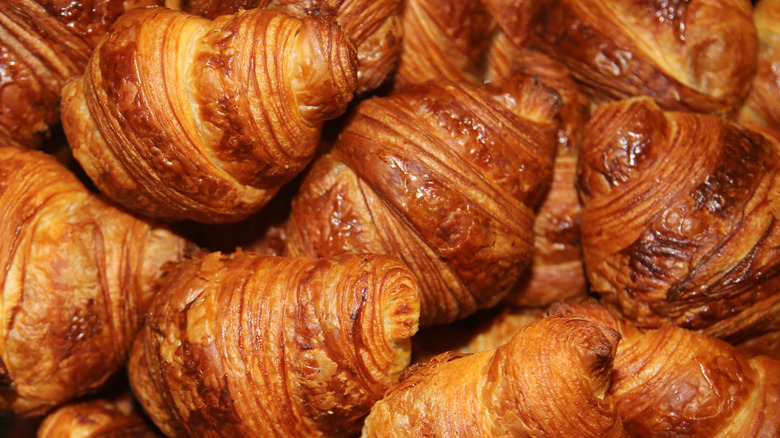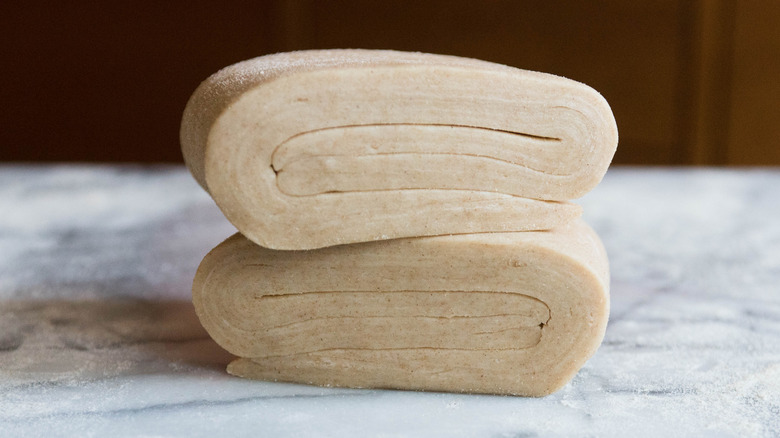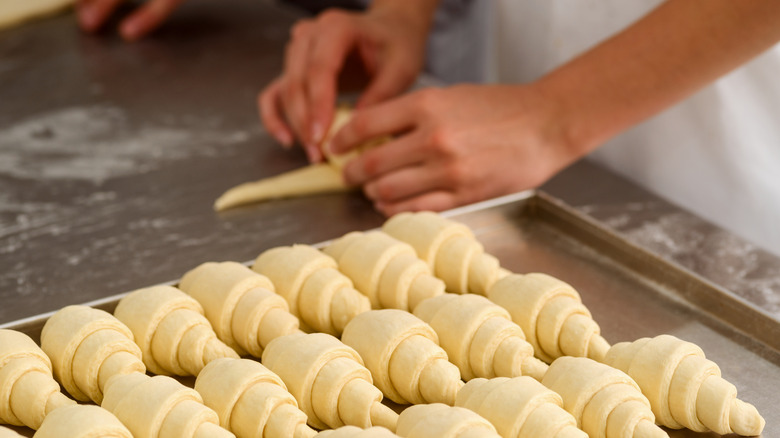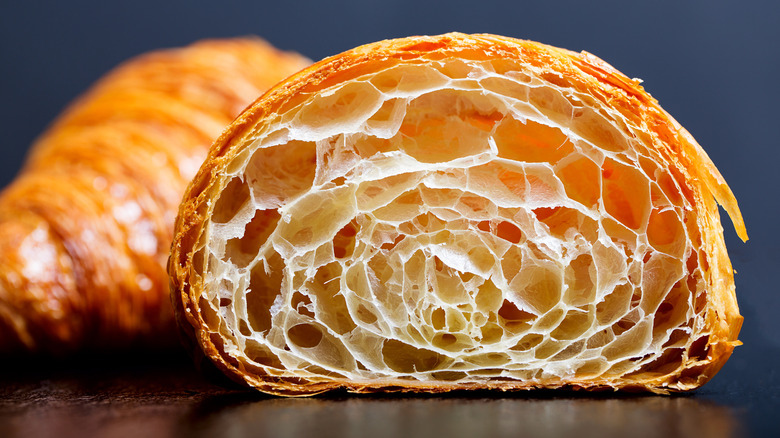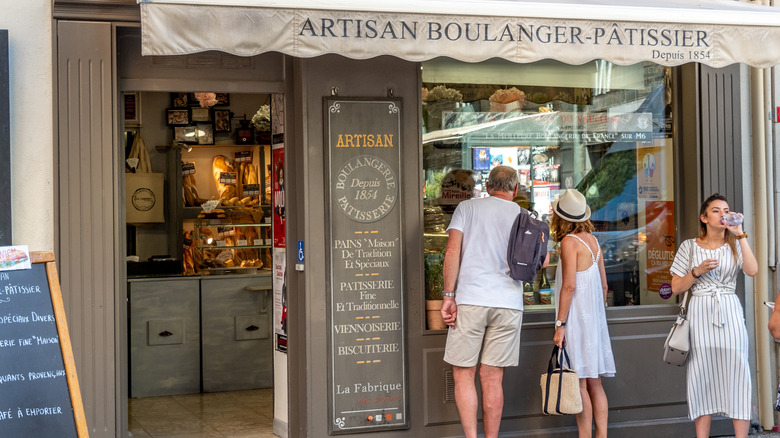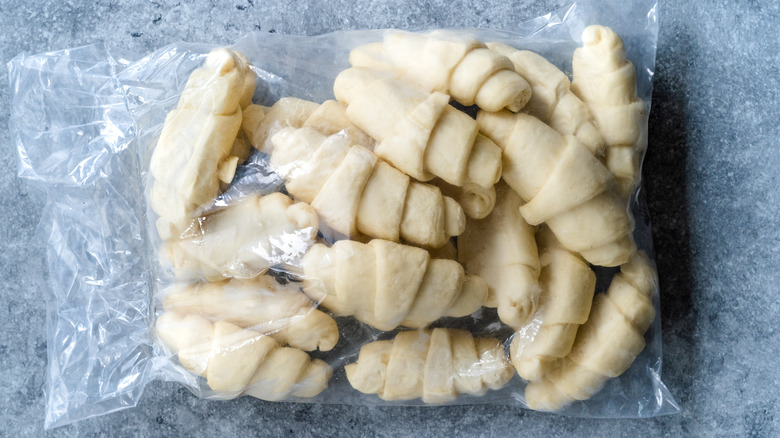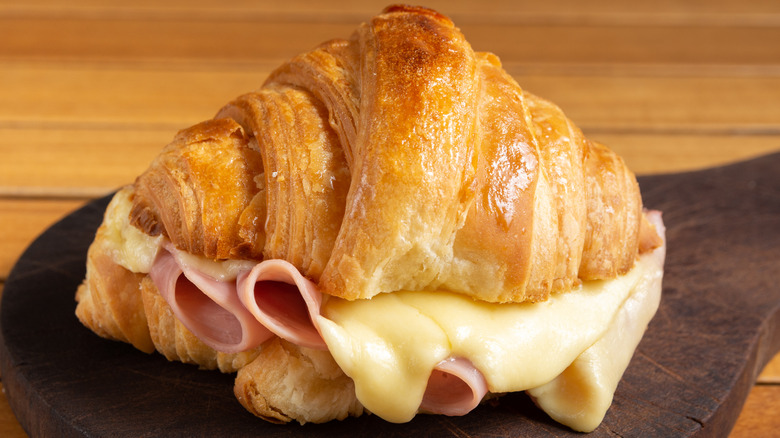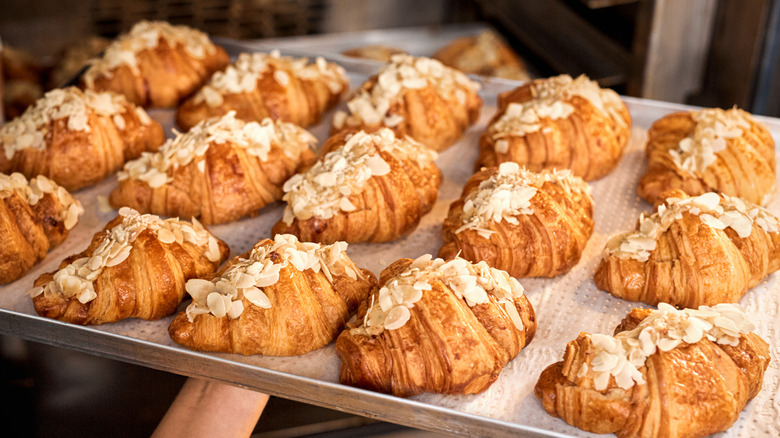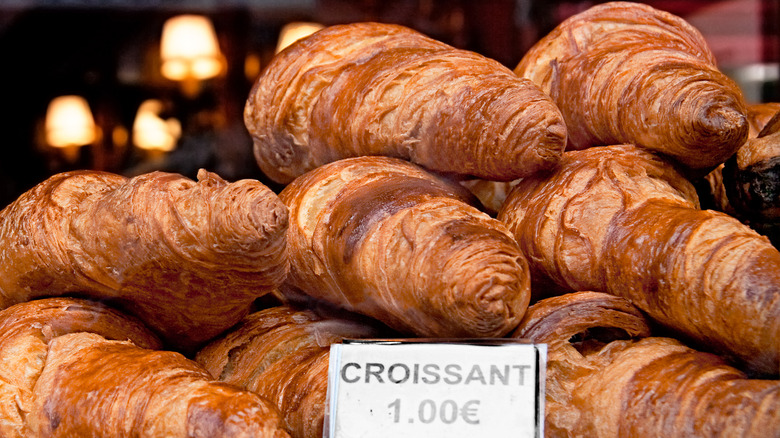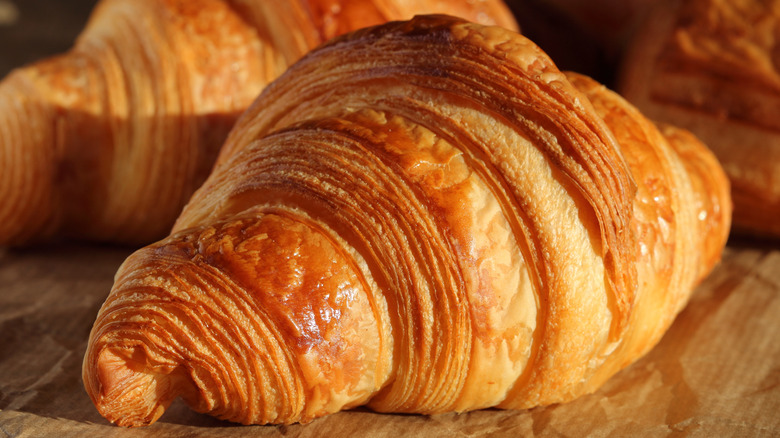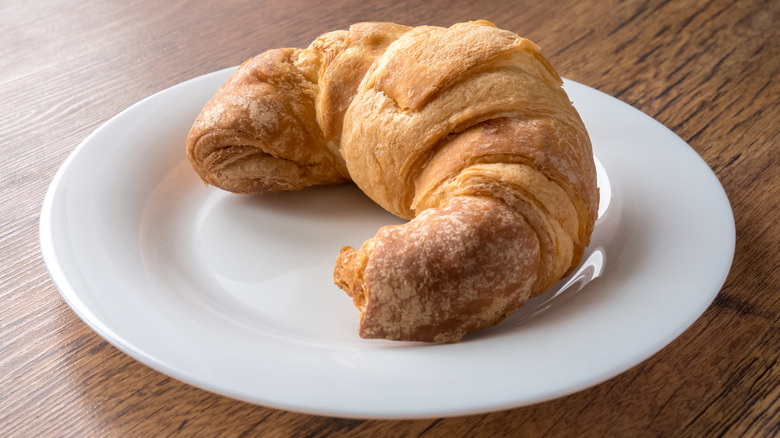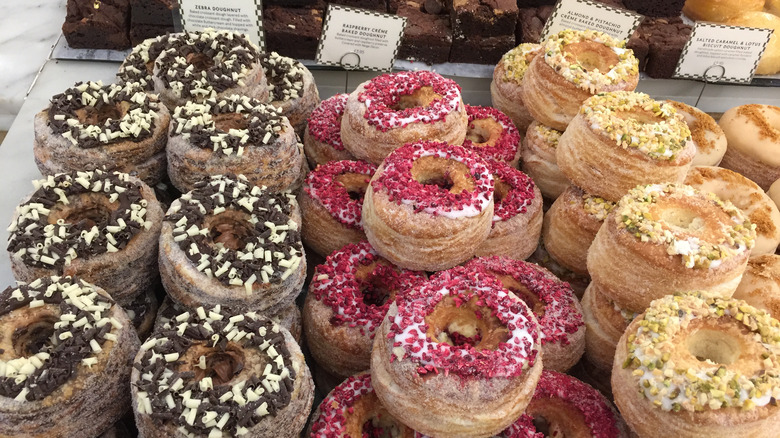The Untold Truth Of Croissants
Flaky, buttery pastries are an easy sell, and croissants are no exception. Light and airy yet satisfyingly crispy on the exterior, these treats are enough to make anyone stray from a strict regimen. While it might seem like croissants have been around forever, they've actually undergone their own evolution. Though you might find French people who are reticent to agree, the layered delicacy isn't even originally French.
From its convoluted history (of questionable veracity) to modern-day creations inspired by its multidimensional flakiness, the croissant has certainly left its mark on the culinary world. That being said, there's a lot more to the golden pastry than meets the eye, and its seemingly simple nature conceals plenty hidden under rich buttery layers.
If you're a fan of delicious baked goods, you should pop by your local boulangerie to scoop up a few as you sit back to discover the untold truths of croissants.
The original croissant wasn't French
You'll find them at bakeries, cafes, and supermarkets across France, but croissants did not originate in the country that holds them so dearly. According to Smithsonian Magazine, in 1683, the Austrians baked up a buttery crescent-shaped cookie to celebrate winning against the Ottomans during the siege of Vienna. Although the story goes that the kipferl (or kipfel) was shaped based on the Ottoman flag, records mention the cookies about 400 years earlier.
Half-moon shaped breads were also popular hundreds of years before, suggesting the design was simply popular among bakers and consumers. Kipferl was a very primitive croissant, and the pastry changed in some fundamental ways in the decades after it arrived in France. Unlike the flaky layers of a croissant, a bite of a kipferl will melt decadently in your mouth.
Biscuit People notes that the Austrian baked good is typically made with ground hazelnuts or almonds (as well as flour, sugar, butter, eggs, and leavening), producing a far denser and crumblier cookie compared with airy croissants. The outlet also points out that kipferl is typically baked and consumed around the Christmas holidays, usually generously sprinkled with powdered sugar.
A number of legends tell its story
Although consensus sets the kipferl as a predecessor to croissants, the leap from one to the other is less clear. Marie Antoinette is mentioned in one particular origin tale per Smithsonian Magazine, suggesting that when she moved from Austria to France, she requested the kipferl be brought to her new homeland. However, there isn't much to back up this claim, and croissant expert and historian Jim Chevallier indicates no evidence to confirm it.
What is certain is that in the 1830s, Viennese baker August Zang opened a bakery in Paris and began selling the cookies (via The Recipe). Already, the signature Austrian treat changed as Zang's oven emitted plenty of steam, producing a shiny exterior and a flaky pastry. Unsurprisingly, it was quickly loved by the French, who immediately began making their own versions of the crescent-shaped pastry.
The Recipe indicates that in the 1860s, the French dictionary included an entry for croissants, describing the half-moon treat. Still to this day, the French refer to buttery flaky pastries as viennoiseries, confirming their origin in Vienna. However, light airy croissants as we know them today were still a couple of decades away.
The recipe for croissants as we know them was developed in the 20th century
The French were scarfing down newly discovered croissants with glee, yet the pastry still had more semblance to a brioche. In his book "August Zang and the French Croissant: How the Viennoiserie Came to France," Jim Chevallier reports that the first croissant recipe featuring puff pastry came about in 1906. The flaky dough was not novel to France, but Chevallier notes it had previously only been used as a base for a filling, never on its own.
However, it was another decade before the flaky laminated yeast-leavened croissant recipe of today was recorded. In his book "La Cuisine Anglo Americaine," French baker Sylvain Claudius Goy introduced the use of yeast and adding butter to every layer. By repeatedly folding the leavened dough over butter, the result was light, airy, and irresistibly flaky. Sacreblue! explains that as the pastry bakes in a hot oven, the butter evaporates and in turn, each layer of pastry puffs up.
Instead of a denser style of baked good like the kipferl, croissants spring back with every bite. Laminated dough is not quite the same as puff pastry which yields a solely crispy result. The former used for croissants incorporates milk and sugar, producing a slightly sweetened dough that has a crunchy exterior and a soft elastic interior that make the treat so delightfully decadent.
Making croissants requires patience
"There is a faster recipe, and it takes less than 24 [hours], most of it leisure time. Book a round-trip flight to Paris." If this comment from the NYT Cooking croissants recipe is anything to go by, you might want to skip the laborious task of making your own croissants; as The Guardian notes, "Life is too short."
However, if you're up for the daunting multistep process, know that croissants aren't the kind of pastry you can bake up on a whim when the craving strikes. Michel Lyckzak is a pro at making croissants — his pastries won the best butter croissants award in 2014 — and he says that aside from using ingredients of high caliber, the secret to multilayered flaky croissants is to refrigerate the dough after each time you fold it with butter (via Smithsonian Magazine).
If you opt to skip the bakery and make a batch of croissants yourself, Audrey from Pardon Your French warns home bakers that it's an intermediate to advanced-level project. She offers a one, two, or three-day croissant recipe, but notes that the latter is undoubtedly the best. Rest assured it probably won't take much more than three hours of active time, but it's worth knowing upfront that you won't be able to indulge until a few days later. Regardless of whether they turn out like bakery croissants, it shouldn't be too much of a chore to eat whatever flaky concoction you create.
There are mathematical equations behind the multiple layers
You might reduce them to a flaky pastry, but in fact, croissants depend on a carefully crafted combination of layers. Chalkdust, a magazine for the mathematically curious, features an article on the croissant equation. The outlet indicates that taking a bite of a croissant can entail sinking your teeth into 500 or more layers of dough!
Consider that from the start, butter is layered between two slabs of dough. The baker then rolls it out before folding the mass into three. To prevent the butter from melting into the dough, the mass must be chilled between each fold (hence the long wait time). Chalkdust counts nine layers of butter between 10 layers of dough after the second round of folding, and the number continues to multiply by three with each step.
Typical recipes will stop after three or four folds, but that's already counting 27 or 81 layers! Considering that the baker slices the folded rectangle of dough into triangles that are further rolled — mathematical equations aside — it's not a stretch to say that the average croissant can easily consist of 200-500 layers of dough, creating the light airy crunch croissant dreams are made of.
Home bakers need not despair: King Arthur Baking reports that its baking ambassador found far more success with fewer folds, so there's certainly room for experimentation if you're so inclined — or, leave it up to the experts.
The pastry was once only reserved for the rich
Although croissants are ubiquitous nowadays, the flaky treat was once reserved for the upper class (via Facts About Anything). While ingredients like butter, sugar, and eggs, are considered staples for most modern home bakers, they were relatively pricey back in the 19th century. Consequently, the buttery pastries were deemed luxury goods and they weren't sold in vast numbers to the general public. In fact, the croissant is listed as a fantasy or luxury bread in a book about food from 1853 (via Taste Tube).
Thankfully for anyone who appreciates a rich flaky baked good, the cost of these ingredients decreased in the 20th century, making croissants more affordable for the average person — and no sooner did prices decrease that croissant production rose dramatically. Currently, croissants in France range from €0.85 to €1.10 (about $0.95 to $1.20) according to Support Ivy, but you'll probably pay between $2.50 to $6 in the US, based on a list of the country's top spots collected by Eat This, Not That.
Industrialization made the pastry more widespread
Expensive ingredients and a labor-intensive process imposed some limits on croissant production. Following World War I and the increased use of margarine, croissants were able to be sold to a greater number of people, according to Paris Unlocked. The outlet explains that this transition led to two distinct recipes for croissants: those made with butter and the others made with margarine. Soon, with rises in mass production, croissants joined the repertoire of foods made on a large scale, capable of being frozen or stored on the shelf.
Surprisingly, NPR reports that the trend of industrialized croissants is not limited to supermarkets. It turns out that numerous bakeries purchase frozen premade croissants to save time and money. The art of making croissants requires dedication to quality and patience, which isn't always the case across chain bakeries. Thankfully, artisan bakers are keeping the authentic croissant tradition alive.
The Americanization of croissants peaked in the 1980s
Whether they're Austrian or French, it's easy to agree that croissants are not American. Nevertheless, in the 1980s they rose in popularity in the US, leading to their integration in American cuisine and culture (via The New York Times). Sara Lee croissants helped reboot the company, and they quickly gained traction over its iconic pound cake. Meanwhile, Pepperidge Farm followed suit, selling fresh croissants with a three-day shelf-life to retailers. Then came the fast food companies: Jack-in-the-Box and Arby's introduced a croissant breakfast sandwich, and Burger King released a crois-sandwich (via NYT).
When The New York Times reported on the Americanization of the croissant almost 40 years ago, it quoted analysts who indicated that "manufacturers are safe in assuming that the appeal of this longtime French staple will endure." Decades later, it seems unlikely that croissants are going anywhere. The numbers confirm this, and Statista reports that 142.3 million Americans consumed croissants in 2020.
It can be made in a number of flavors
You're sure to meet croissant fanatics who claim the pastry should never deviate from its simple yet rich nature. Nonetheless, there are some variations you're even bound to find in a boulangerie in France. Everyday Parisian lists a croissant aux amandes and a pain au chocolat (almond croissant and chocolate bread respectively) as popular options.
The almond croissant is typically covered in sliced almonds and powdered sugar and filled with almond cream. According to Everyday Parisian, the pastry was once made with day-old croissants, however, bakeries tend to bake them fresh nowadays. Although pain au chocolat does not hint at it from the name, it is in fact a butter croissant with a stick of chocolate through the middle. The shape is a rectangle, not a spiral (hence the lack of croissant in the name), but the layers are no less flaky. If you're lucky to find them and are feeling indulgent, chocolate almond croissants are the way to go.
That's not to say you won't come across all sorts of croissant fillings if you've found yourself in an experimental bakery. Fuji Bakery in Seattle boasts a pumpkin pie croissant, Supermoon Bakehouse in NYC has a pecan pie version, and Pierre Hermé in Paris is known for its Ispahan croissant: rose almond paste, raspberry litchi compote, rose water glaze, and crushed raspberries (via AFAR). Meanwhile, ham and cheese croissant sandwiches make regular appearances even at bakeries in France (via PAUL).
The best ones are found at bakeries
Unless you're a skilled pastry chef, it will probably take you some practice to get the hang of making croissants. Chances are greater that you'll end up buying the treat more regularly than baking it yourself. Thanks to their popularity, croissants can be found in supermarkets, restaurants, cafes, bakeries, and even on some fast-food menus. However, for the most authentic experience, you're going to want to get the flaky pastry from a bakery.
Think about it: Bakers deal with dough all day every day. The subtle nuances of fermenting yeast, rising temperatures, and the malleability of dough take a long time to perfect, so why not get your croissants somewhere seeking that exact precision? PAUL Bakery has been honing its craft for 130 years, and its website writes, "The golden rule is to eat a freshly baked croissant." Really, the only way you'll achieve that is by purchasing them by the unit at a bakery.
Though it might be tempting to lounge over a café au lait and croissant at a streetside cafe, Alex from French Guy Cooking notes that you're likely to be served a stale lackluster pastry. Pop into a bakery (for best results, in France) and ask for a croissant to take away. The best part about eating it on the go? You'll be able to carelessly shake off flaky crumbs on the sidewalk without worrying about the mess!
Flakiness and a dark golden color are signs of a good croissant
Given the complex recipe and multistep process of making croissants, it's no surprise that people opt for shortcuts. While that's acceptable for home bakers, it's disappointing to purchase a bakery croissant and discover that it's lacking the qualities that make the treat so delicious. Thankfully, a few characteristics can nudge you in the right direction when making a choice. (Of course, the alternative won't necessarily be bad, it just won't have all the authentic features of a properly made croissant.)
French Guy Cooking notes that for starters, you should skip any soft or overly dense pastries pretending to be croissants. The shiny golden shell on the outside should break apart into a flaky mess, confirming its high butter content. If the pastry is made with margarine it will hold together far more neatly. While that might be a selling point for some people, most would argue that butter is the essence of a croissant — specifically, richly caramelized.
The base of the pastry should be darker than the top, which Alacarta explains proves that it's baked in an artisanal oven versus an industrial one. Apart from piles of crumbs as you eat it, the croissant should have visible layers; remember, there are hundreds of them! Finally, a slight hint of salt is another sign of a well-made pastry, as a sprinkle of fleur de sel is added to croissant dough to enhance the flavor.
The shape hints at the ingredient quality
For anyone eager to enjoy a croissant in its pure buttery form, it's disconcerting to think that margarine might be swapped in. Curious Rambler indicates that the alternative became popular in the 19th century thanks to its reduced cost and longer shelf-life. However, what seems like an easy way to save money has a number of effects on the final product.
Thankfully, you don't have to find out in your first bite as (mainly in France) bakers use two shapes to delineate the contents. The New Yorker explains that croissants containing margarine (even only a proportion) must (by law!) have curved crescent-shaped edges. Meanwhile, 100% butter croissants can be any shape they desire, though they are usually straight to avoid confusion. Given the fact that the pastry was first created as a half-moon, it is a bit perplexing that the shape would no longer signal the authentic buttery treat.
British supermarket giant Tesco added its own two cents to the discussion by shifting its crescent-shaped croissants to straight ones in 2016, according to The Guardian. The reason? To make it easier to spread jam and butter in a swift motion (an entirely unnecessary add-on according to many French people). Per the Tesco website, they seem to be made with pure butter, which at least limits some confusion.
They're meant to be eaten at breakfast with coffee
Feel free to eat a croissant when the craving strikes, but know that if you're in France, having them beyond breakfast might result in haughty looks. As it turns out, French people tend to limit their consumption of the buttery treat to the morning (perhaps so they can work it off throughout the day). The Guardian adds that "unless you live a life of gilded luxury" you should only be eating the pastry on weekends. While we don't necessarily agree, given the masses of butter you're ingesting, you probably don't want to have them every single morning.
Coffee's bitter aromas are a welcome contrast to the buttery richness of croissants and are perfect for breakfast. However, whether or not you're meant to dip the flaky pastry into the coffee is another debate. PAUL Bakery writes in "The Art of the Croissant" that dunking it into a hot coffee is an assured way to avoid a flaky mess when you take a bite. The outlet claims that it's a typical French custom, however, the comments on one influencer's Instagram video tell otherwise.
It seems that with many beloved foods, the specific nuances of consumption are steeped in rigid thinking. Let's be clear: The buttery treat should be a source of joy, no matter how or when you decide to eat it.
Croissant purists should steer clear of hybrid creations
It's only natural to want to experiment with a winning combination, and that's true of a classic croissant and its buttery flaky layers. While it's hard to keep up with the multitude of hybrid concoctions — The New Statesman lists cronuts, croiffles (croissant waffles), and cragels (croissant bagels) in its article title alone — cronuts set off the trend when French baker Dominique Ansel invented them in his NYC bakery in 2013 (via Wired).
Ansel tells Condé Nast Traveler that the creation developed from comments that he sold no donuts. Once he released cronuts the flocks came, and Ansel's bakery had daily lineups as long as cronuts were available. Business Insider even reported that the pastry's exclusivity spawned a cronut black market on Craigslist. Dunkin' Donuts quickly released their own version that had — so the company president claimed — been in the works for some time and was entirely independent of the cronut (via Associated Press).
Almost 10 years later, cronuts have become a mainstay in bakeries countrywide, leading to plenty of other hybrids. While a cruffin (croissant muffin), cretzel (croissant pretzel), and crupcake (croissant cupcake) are perhaps more intuitive, other variations like crossushi or tacros seem harder to swallow.
